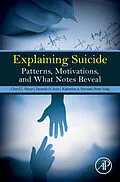The rate of suicides is at its highest level in nearly 30 years. Suicide notes have long been thought to be valuable resources for understanding suicide motivation, but up to now the small sample sizes available have made an in-depth analysis difficult. Explaining Suicide: Patterns, Motivations, and What Notes Reveal represents a large-scale analysis of suicide motivation across multiple ages during the same time period. This was made possible via a unique dataset of all suicide notes collected by the coroner's office in southwestern Ohio 2000-2009. Based on an analysis of this dataset, the book identifies top motivations for suicide, how these differ between note writers and non-note writers, and what this can tell us about better suicide prevention. The book reveals the extent to which suicide is motivated by interpersonal violence, substance abuse, physical pain, grief, feelings of failure, and mental illness. Additionally, it discusses other risk factors, what differentiates suicide attempters from suicide completers, and lastly what might serve as protective factors toward resilience. - Analyzes 1200+ suicide cases from one coroner's office - Identifies the top motivations for suicide that are based on suicide notes - Discusses the extent to which suicides are impulsive vs. planned - Leads to a better understanding on how to prevent suicide - Emphasizes resilience factors over risk factors
Autorentext
Cheryl L. Meyer has blended together a unique combination of degrees including a Master's degree in Clinical Psychology, a Ph.D. in Social Psychology and a law degree. Her research has an interdisciplinary focus incorporating legal, educational, psychological and sociological perspectives. Dr. Meyer's research interests focus on forensic psychology, specifically intrafamilial violence, and program evaluation. She has published several books, been quoted widely in newspapers or magazines, and has appeared on numerous radio and television shows, most notably, 60 Minutes. Dr. Meyer is a Professor at Wright State University School of Professional Psychology. From 2010-2015 she was awarded the title Board of Trustees University Professor for her outstanding contributions beyond the confines of her own discipline.
Inhalt
1. The History and Theories of Suicide 2. Findings 3. Suicide Motivated by Interpersonal Relationships 4. Escape as a Motivation for Suicide 5. Grief and Failure 6. The Complexity of Suicide Motivation 7. Severe Mental Illness 8. The Intersection of Suicide and Legal Issues 9. Protective Factors and Resilience 10. Conclusions and Implications
